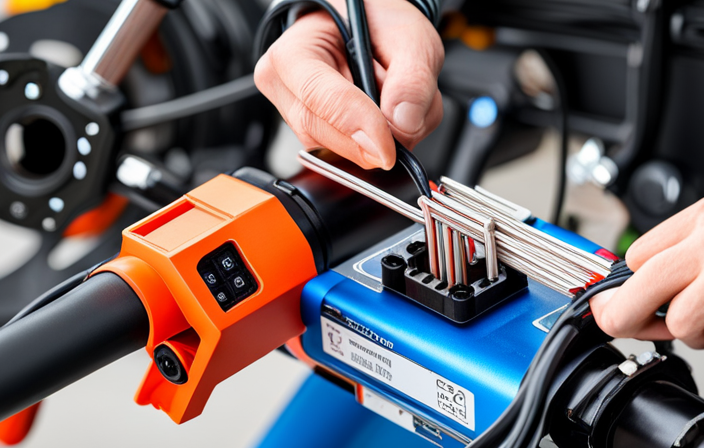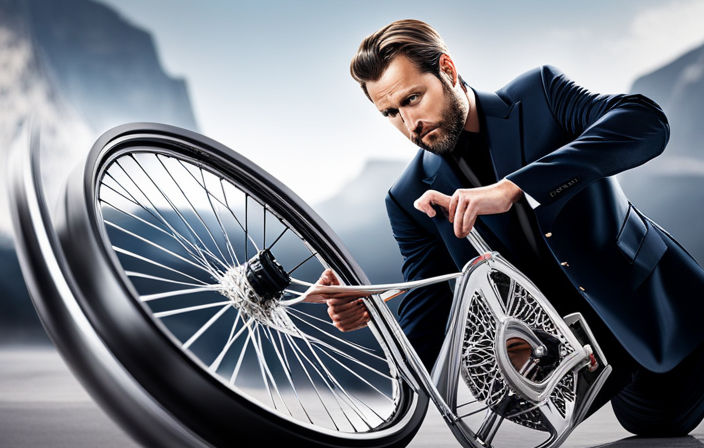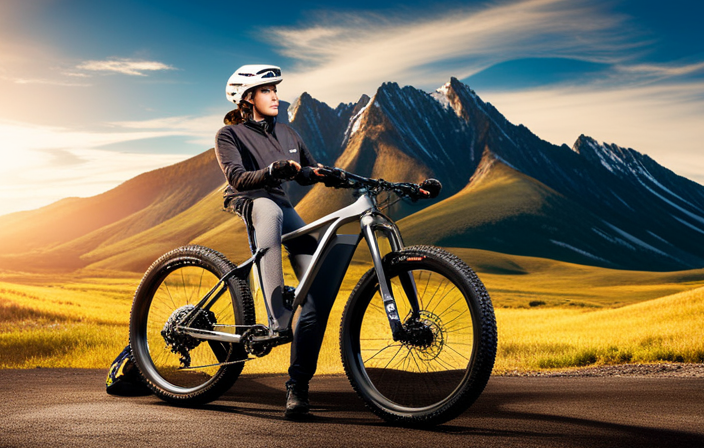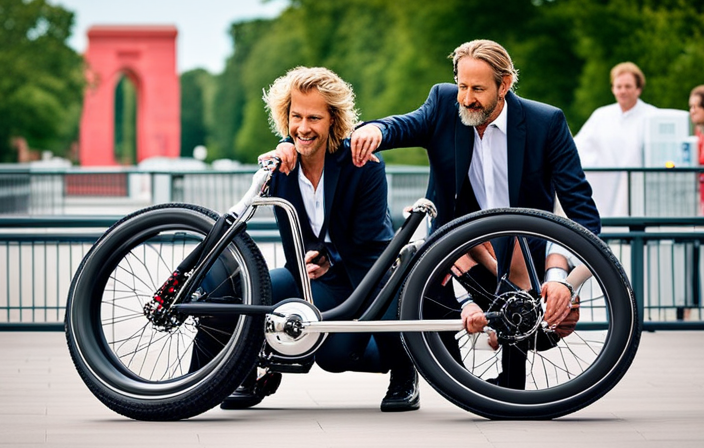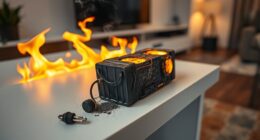As a DIY enthusiast and electric bike enthusiast, I understand the thrill of upgrading and customizing your own electric bike.
One essential aspect of this process is wiring the ESC (Electronic Speed Controller) correctly. By following this step-by-step guide, you can confidently wire your ESC and unlock the full potential of your electric bike.
Harness the power, enhance your ride, and take your electric bike experience to new heights with this informative and precise tutorial.
Let’s get started!
Key Takeaways
- Proper wiring techniques are crucial for safe and reliable operation of an electric bike’s ESC.
- Following the manufacturer’s instructions and consulting online resources can provide guidance for proper installation.
- Proper wiring helps prevent electrical malfunctions and reduces the risk of short circuits.
- Implementing proper wiring techniques improves overall performance and prolongs the lifespan of electrical components.
Gather the Necessary Tools and Materials
Before you can start wiring the ESC for your electric bike, gather all the necessary tools and materials.
To ensure a successful DIY project, you will need a soldering iron, solder wire, wire strippers, heat shrink tubing, heat gun, electrical tape, and a multimeter. These tools are essential for properly connecting the wires and ensuring a secure and efficient electrical connection.
In addition to the tools, you will also require some materials such as silicone wires, connectors, zip ties, and a suitable enclosure for the ESC. The silicone wires are ideal for high-temperature applications and provide excellent flexibility.
Once you have gathered all the tools and materials, you can move on to understanding the basics of wiring an ESC, which will allow you to safely and effectively wire your electric bike.
Understand the Basics of Wiring an ESC
To properly set up an ESC for an electric bicycle, it’s important to have a good understanding of the wiring basics. Here are some key wiring techniques to keep in mind:
- Make sure to use the appropriate gauge of wire for your ESC, as using the wrong gauge can lead to overheating and potential damage.
- Double-check all connections to ensure they are secure and properly insulated to avoid any short circuits.
- When connecting the ESC to the motor, make sure to match the correct wire colors and follow the manufacturer’s instructions.
- Troubleshooting tip: If you encounter any issues with the wiring, such as the motor not responding or erratic behavior, check for loose connections or damaged wires.
By following these wiring techniques and troubleshooting tips, you can ensure a proper setup for your ESC.
Now, let’s move on to the next step: disconnecting the battery and removing the controller cover.
Disconnect the Battery and Remove the Controller Cover
First, you’ll need to disconnect the battery and take off the controller cover. This is an important step to ensure your safety and prevent any accidental electrical shocks.
Start by locating the battery on your electric bike and disconnecting it from the main power source. Once the battery is disconnected, carefully remove the controller cover by unscrewing the screws that hold it in place. By removing the cover, you’ll be able to inspect the controller and ensure that it is in good condition and free from any damage or loose connections.
After inspecting the controller cover, you can proceed to the next step, which is to identify the motor wires and connect them to the ESC. This will allow the ESC to control the motor’s speed and direction.
Identify the Motor Wires and Connect them to the ESC
Now, you’ll need to locate the motor wires and connect them to the ESC so that it can control the motor’s speed and direction. To identify the motor connections, start by examining the wires coming out of the motor. There are typically three wires: a red wire, a black wire, and a blue or yellow wire.
The red wire is usually the positive wire, the black wire is the negative wire, and the blue or yellow wire is the signal wire. Once you have identified these wires, you can connect them to the corresponding wires on the ESC. Make sure to securely fasten the connections using solder or connectors to prevent any loose connections.
This step is crucial as it ensures that the ESC can effectively control the motor. If you encounter any wiring issues, such as loose connections or damaged wires, troubleshoot and fix them before proceeding.
With the motor wires connected to the ESC, you can now move on to connecting the ESC to the battery and throttle.
Connect the ESC to the Battery and Throttle
Next, you’ll need to connect the ESC to both the battery and throttle. To do this, follow these steps:
- Connect the positive wire from the battery to the positive input on the ESC.
- Connect the negative wire from the battery to the negative input on the ESC.
- Connect the throttle wire to the throttle input on the ESC.
By connecting the ESC to the battery, you are providing power to the motor. The throttle wire allows you to control the speed and acceleration of the electric bike.
It is important to note that you may need to adjust the throttle sensitivity to ensure a smooth and responsive ride. This can usually be done through the ESC’s programming settings. Refer to the manufacturer’s instructions for specific details on how to adjust throttle sensitivity.
Once you have successfully connected the ESC to the battery and throttle, you can proceed to secure the ESC and test the connections.
Secure the ESC and Test the Connections
To ensure proper functionality, make sure to secure the ESC and test the connections after connecting it to the battery and throttle. Here are some testing procedures to follow and verify connections:
-
Use a zip tie or Velcro strap to securely fasten the ESC to a suitable location on your electric bike. This will prevent it from vibrating or moving during operation.
-
Double-check all the connections between the ESC, battery, and throttle. Ensure that the wires are properly connected and there are no loose or disconnected cables.
-
Turn on the power to the ESC and check for any error codes or abnormal behavior. This will help identify any potential issues before riding the bike.
-
Test the throttle response by gradually increasing the speed. Make sure the motor responds smoothly and there are no sudden surges or delays.
By properly securing the ESC and thoroughly testing the connections, you can troubleshoot any issues that may arise during the wiring process.
Troubleshoot any Issues
If any issues arise, troubleshoot them by checking the connections and testing the throttle response. Troubleshooting techniques for ESC-related problems can help identify and resolve common issues.
Firstly, ensure all the connections are securely plugged in and properly insulated to prevent any loose or faulty connections. Check for any damaged wires or connectors that may be causing a poor connection.
Additionally, test the throttle response by gradually applying throttle and observing the ESC’s reaction. If there is a delay or lack of response, it could indicate a problem with the throttle or ESC settings. Adjust the throttle sensitivity and calibration settings as necessary to achieve the desired performance.
By troubleshooting these common ESC issues, you can ensure a smooth and efficient operation of your DIY electric bike.
Moving on to the next section, let’s discuss how to install a throttle and adjust the settings.
Install a Throttle and Adjust the Settings
After troubleshooting any issues with your DIY electric bike’s ESC, it’s time to move on to the next step: installing a throttle and adjusting the settings.
The throttle installation techniques may vary depending on the specific model you have chosen, but typically involve connecting the throttle wires to the ESC and securing it in a comfortable position on the handlebars.
Once the throttle is installed, it’s important to adjust the ESC settings for optimal performance. This includes configuring parameters such as acceleration, braking, and maximum speed. Carefully following the instructions provided with your ESC will ensure you make the necessary adjustments accurately.
Now that the throttle is installed and the ESC settings are optimized, it’s crucial to ensure proper safety measures are in place before taking your electric bike for a ride.
Ensure Proper Safety Measures
Make sure you have all the necessary safety equipment in place before you start riding. Safety precautions are essential when it comes to wiring an ESC for an electric bike.
First and foremost, always wear a helmet to protect your head in case of any accidents. Additionally, it is important to wear protective eyewear, gloves, and sturdy shoes to safeguard yourself from any potential injuries.
When working with electrical components, ensure that the power is turned off and the battery is disconnected to avoid any electrical shocks. Proper wiring techniques should also be followed, such as using the correct gauge of wires, securing connections with tape or zip ties, and avoiding any exposed wires that could cause short circuits.
By taking these safety measures and following proper wiring techniques, you can ensure a safe and enjoyable upgraded electric bike experience.
Enjoy Your Upgraded Electric Bike Experience
To fully appreciate your enhanced e-bike experience, make sure to embrace the thrill of riding with your upgraded features. Electric bike maintenance is crucial to ensure the longevity and optimal performance of your bike. Regularly check the tire pressure, inspect the brakes, and clean the drivetrain to keep your bike in top condition. Additionally, choosing the right Electronic Speed Controller (ESC) for your bike is essential. Consider factors like voltage and current ratings, compatibility with your motor, and programmability options. Research and compare different ESC options to find the one that suits your needs and preferences. Installing the ESC properly is crucial for the safe and efficient operation of your electric bike. Take the time to carefully follow the manufacturer’s instructions and consult online resources for guidance. With proper maintenance and the right ESC, you can enjoy a smooth and exhilarating ride on your upgraded electric bike.
| Electric Bike Maintenance | Choosing the right ESC for your bike |
|---|---|
| Regularly check tire pressure | Consider voltage and current ratings |
| Inspect brakes for wear and tear | Check compatibility with your motor |
| Clean the drivetrain | Look for programmability options |
| Follow manufacturer’s instructions | Research and compare ESC options |
| Consult online resources for guidance | Install the ESC properly |
Frequently Asked Questions
What tools and materials do I need to wire an ESC for an electric bike?
To wire an ESC for an electric bike, you’ll need a few essential tools and materials. These include wire cutters, soldering iron, heat shrink tubing, electrical tape, connectors, and a wiring diagram. For efficient wire management, follow ESC wiring techniques and use cable ties to secure the wires in place.
How do I identify and connect the motor wires to the ESC?
To identify and connect the motor wires to the ESC, start by understanding the motor wire color coding. Avoid common mistakes like mixing up the wires or connecting them incorrectly. Follow the precise instructions provided and ensure a secure and accurate connection.
What safety measures should I take when wiring an ESC for an electric bike?
Safety precautions are crucial when wiring an ESC for an electric bike. Proper insulation is of utmost importance to prevent short circuits and potential hazards. Ensure all connections are secure and insulated to protect yourself and the bike.
How do I troubleshoot any issues that may arise during the wiring process?
To troubleshoot common issues during the wiring process of an ESC for an electric bike, I recommend testing the functionality of each component individually, checking for loose connections, and ensuring proper insulation to avoid short circuits.
How do I install a throttle and adjust the settings for the ESC on my electric bike?
To install a throttle and adjust the settings for the ESC on my electric bike, I must first familiarize myself with the throttle adjustments and ESC programming. This precise process ensures optimal performance and control while riding.
Conclusion
In conclusion, wiring an ESC for an electric bike DIY project requires careful attention to detail and the right tools. By understanding the basics of wiring and following the step-by-step process, you can successfully upgrade your bike.
Remember to troubleshoot any issues that may arise and ensure proper safety measures are in place.
Now, picture yourself cruising down the road on your newly upgraded electric bike, feeling the power and exhilaration. Isn’t it time to take your biking experience to the next level?
